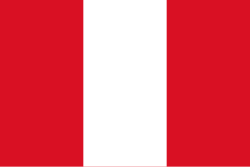Peru
From Wikipedia, the free encyclopedia
Remove ads
Peru ntchalo icho chili ku manjililo gha dazi gha kummwera kwa Amerika.
- In Peru, other languages have been officially recognized as legitimate autochthonous languages.
- Quechua: Piruw Ripuwlika
- Aymara: Piruwxa Ripuwlika
- The 2017 National Census included, for the first time, a question of ethnic self-identification that was addressed to people aged 12 and over considering elements such as their ancestry, their customs and their family origin to visualize and better understand the cultural reality of the country.
- Shugart, Matthew Søberg (September 2005). "Semi-Presidential Systems: Dual Executive and Mixed Authority Patterns" (PDF). Graduate School of International Relations and Pacific Studies. Archived from the original (PDF) on 19 August 2008. Retrieved 31 August 2017.
- Shugart, Matthew Søberg (December 2005). "Semi-Presidential Systems: Dual Executive And Mixed Authority Patterns". French Politics. 3 (3): 323–351. doi:10.1057/palgrave.fp.8200087. ISSN 1476-3427. OCLC 6895745903.
Only in Latin America have all new democracies retained a pure presidential form, except for Peru (president-parliamentary) and Bolivia (assembly-independent).
- "DataBank - Population estimates and projections" (in English). The World Bank. 2023. Retrieved 6 January 2023.
- "Gini Index". World Bank. Archived from the original on 7 May 2020. Retrieved 14 July 2021.
- "Human Development Report 2021/2022" (PDF) (in English). United Nations Development Programme. 8 September 2022. Retrieved 8 September 2022.
Remove ads
Wikiwand - on
Seamless Wikipedia browsing. On steroids.
Remove ads




